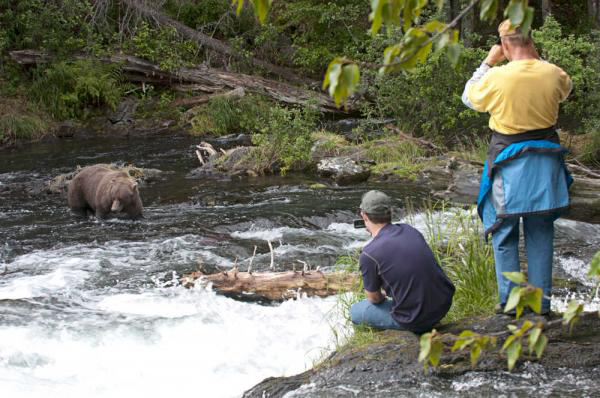A duo of adolescent bears has been causing a stir at the confluence of the Kenai and Russian rivers.
The pair has been spotted working together to gather their meals.
The Kenai National Wildlife Refuge and U.S. Forest Service are providing notification to all anglers warning them of the recent uptick in wildlife approaching visitors for fish, said Deputy Refuge Ranger Steve Miller.
“There have been more reports of people losing fish or backpacks,” Miller said. “It’s becoming concerning.”
When animals find food sourced by humans, they become comfortable around people, and more likely to return expecting the same result, Miller said. That can lead to negative encounters if they are met with resistance or do not find what they are looking for, he said.
The young brown bears spurring most of the recent reports have acclimated to human activity, Miller said. The notice was issued to remind people of regulations already in place to diminish potential human-bear conflicts, he said.
The Kenaitze Indian Tribe, U.S. Forest Service and Kenai National Wildlife Refuge work together to regulate the area surrounding the Russian River Ferry, said Refuge Chief of Visitor Services Matt Conner.
The Code of Federal Regulations outlines the requirements visitors in the area must adhere to.
Code states that anyone using public lands must keep all personal property that can be used to cook or store food within 3-feet of a person for quick access, stored in a bear-resistant container or left in a car.
Stringers and whole fish should be kept within 12 feet of the owner at all times, according to federal code.
A fisherman himself, Conner sympathizes with the tunnel vision impulse when fishing. Belongings and caught salmon can slip under the radar, he said.
Conner said he recently heard a story of a visitor dropping a backpack on the ground, when a bear 30-to-40 yards away reacted and began to approach. The woman picked up the backpack and found refuge in a larger, nearby group, and the animal’s advances were deterred.
The story itself is not significant, but it is a direct example of a bear having developed a “trigger response,” Conner said. The sound of the luggage hitting the ground signaled a potential source of food for the bear, he said.
Once a bear has learned a behavior, it is hard to unlearn, Conner said.
“The bear has realized, ‘If I do this action I get food as a reward,’” Conner said. “If people kept their fish close and their backpacks close, it is possible that behavior will go away.”
Keeping close tabs on personal belongs, particularly ones that may attract wildlife, may seem like a small inconvenience, but it will make a huge difference, he said.
Right now there are two, potentially three, pesky bears, but there is no such thing as “a bear that it is used to people,” Conner said. The animals become habituated, but are still entirely wild and have the potential to “escalate in a millisecond,” he said.
Reach Kelly Sullivan at kelly.sullivan@peninsulaclarion.com.

